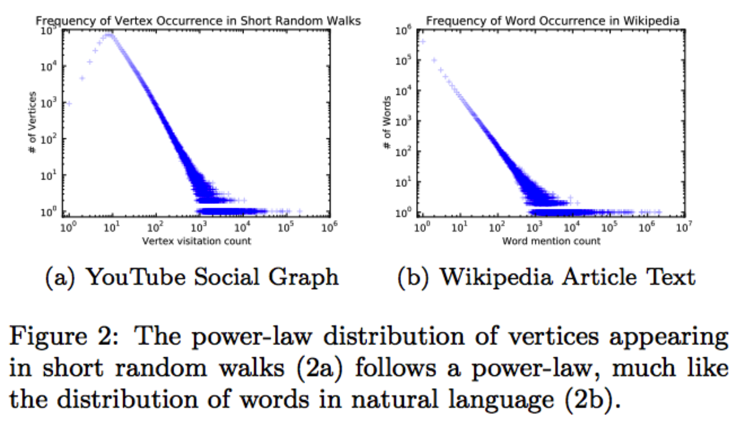《DeepWalk: Online Learning of Social Representations》是一篇我个人非常喜欢的论文,不仅提出了一个想法,更展示了这个想法的可行性和可能空间。提出的想法是利用网络结构信息将用户表示为低维实值向量,学出来的表示是最重要的,因为有了表示就可以用来加在许多其他任务上。
而这个想法本身也是来自于一个有趣的观察和迁移。
- 观察是:

If the degree distribution of a connected graph follows a power law (is scale-free), we observe that the frequency which vertices appear in the short random walks will also follow a power-law distribution
- 迁移是:源于这个 frequency,作者想到了 NLP 中的 word frequency。word frequency 在 NLP 中有一个基本的假设是,在同一个文本语料中是同分布的。由此带来了 frequency -> distribution 的一种关联,作者将这种关联“迁移”到了他的模型中,进而将 NLP 中的 distributed word representation 思想用在了 social network 中的节点表示上。
A core contribution of our work is the idea that techniques which have been used to model natural language (where the symbol frequency follows a power law distribution (or Zipf ’s law)) can be re-purposed to model community structure in networks.
本文除了想法和各种迁移的顺畅外,我觉得还有论文写法和实验设计值得学习。写法上,本文并不算完全的中规中矩,且有各种对广为流传的算法的改进。越多这样的改进越可能造成描述的混乱,让人摸不清主线,但是这篇论文并没有这样的感觉。基本方法就是在 method 的不同 part 之前,加入连接段,having ..., we now need 这样的表示;同时还有在描述自己如何改进算法前,先说这个算法的 basic idea, why fit, why not fit and that is the part we should modify;第三个就是善用加粗/斜体和全部大写,从格式上强调。
本文实验部分是我觉得非常 solid 的:(1)用的是标准公开数据集,不是自己 deliberately selected data;(2)baseline 选的都很合适,没有 feature design;(3)自己的实验,不同参数的 sensitivity 讨论。唯一缺乏的可能是 existing methods 但是无妨。
源码:https://github.com/phanein/deepwalk
P.S.:作者这个实验室我发过几次邮件,非常热情细致,回复得特别仔细,好实验室啊。